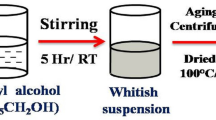Abstract
The effect of Er3+ doping on the thermal stability of TiO2 nanoparticulate xerogels prepared by a colloidal sol–gel route was investigated. It was found that the as-synthesized xerogels crystallize as anatase phase with crystallite sizes in the low nanoscale range (<7 nm) and high-specific surface areas (>100 ± 5 m2/g). Nevertheless, it was also found that the Er3+ cations are deposited on the surface of TiO2 nanocrystallites thus resulting in xerogels with smaller and more uniform nanoaggregates. Most importantly, detailed analyses using X-ray thermo-diffractometry together with selective analyses by transmission electron microscopy, selected area electron diffractometry, and X-ray energy-dispersive spectrometry showed that the thermal stability of these TiO2 nanoparticulate xerogels increases with increasing Er3+ doping. Specifically, the nanocrystallite growth is slowed down, the onset temperature of the anatase-to-rutile phase transformation is delayed, and the anatase phase is retained up to greater temperatures as the Er3+ content increases, which are all phenomena attributable to the formation at low temperatures (i.e. ~200 °C) of solid solutions with Er3+ solutes within the TiO2 host. Moreover, these solid solutions also have lower thermal expansion coefficient than the undoped crystal structure. Finally, Er3+ doping increasingly promotes the precipitation at high temperatures of Er2Ti2O7 from the rutile TiO2 solid solution, with the precipitation temperature decreasing with increasing Er3+ doping content.











Similar content being viewed by others
Notes
Quantitative phase-composition analysis without a standard from the peak intensities requires the use of certain crystallographic parameters such as the Debye–Waller temperature factor, the structure factors, and the lattice parameters (Klug and Alexander 1974). These are unknown in the present case because they are affected by the change in temperature and/or the entry of Er3+ cations into solution in the TiO2 crystal lattice.
References
Arbiol J, Cerdà J, Dezanneau G, Cirera A, Peiró F, Cornet A, Morante JR (2002) Effects of Nb doping on the TiO2 anatase-to-rutile phase transition. J Appl Phys 92(2):853–861
Borlaf M, Poveda JM, Moreno R, Colomer MT (2012a) Synthesis and characterization of TiO2/Rh3+ nanoparticulate sols, xerogels and cryogels for photocatalytic applications. J Sol-Gel Sci Technol 63(3):408–415
Borlaf M, Wu HM, Colomer MT, Moreno R, Tseng WJ (2012b) Synthesis and characterization of anatase-structured titania hollow spheres doped with erbium (III). J Am Ceram Soc 95(9):3005–3011
Borlaf M, Colomer MT, Cabello F, Serna R, Moreno R (2013) Electrophoretic deposition of TiO2/Er3+ nanoparticulate sols. J Phys Chem B 117(6):1556–1562
Cacciotti I, Bianco A, Pezzotti G, Gusmano G (2011) Synthesis, thermal behaviour and luminescence properties of rare earth-doped titania nanofibers. Chem Eng J 166(2):751–764
Cheng H, Selloni A (2009) Energetics and diffusion of intrinsic surface and subsurface defects on anatase TiO2(101). J Chem Phys 131(5):054703
Favennec PN, L’Haridon H, Salvi M, Moutonnet D, Le Guillou Y (1989) Luminescence of erbium implanted in various semiconductors: IV, III–V and II–VI materials. Electron Lett 25(11):718–719
Gouma PI, Mills MJ (2001) Anatase-to-rutile transformation in titania powders. J Am Ceram Soc 84(3):619–622
Hishita S, Mutoh I, Koumoto K, Yanagida H (1983) Inhibition mechanism of the anatase–rutile phase transformation by rare earth oxides. Ceram Int 9(2):61–67
Kenyon AJ (2002) Recent developments in rare-earth doped materials for optoelectronics. Prog Quant Electron 26(4–5):225–284
Klug HP, Alexander LE (1974) X-ray diffraction procedures for polycrystalline and amorphous materials. Wiley, New York
Michels A, Krill CE, Ehrhardt H, Birringer R, Wu DT (1999) Modelling the influence of grain-size-dependent solute drag on the kinetics of grain growth in nanocrystalline materials. Acta Mater 47(7):2143–2152
Saif M, Abdel-Mottaleb MSA (2007) Titanium dioxide nanomaterial doped with trivalent lanthanide ions of Tb, Eu and Sm: preparation, characterization and potential applications. Inorg Chim Acta 360(9):2863–2874
Satoh N, Nakashima T, Kamikura K, Yamamoto K (2008) Quantum size effect in TiO2 nanoparticles prepared by finely controlled metal assembly on dendrimer templates. Nat Nanotechnol 3(2):106–111
Shannon RD, Pask JA (1964) Topotaxy in the anatase–rutile transformation. Am Mineral 49(11–12):1707–1717
Shannon RD, Pask JA (1965) Kinetics of the anatase–rutile transformation. J Am Ceram Soc 48(8):391–398
Spurr RA, Myers H (1957) Quantitative analysis of anatase–rutile mixtures with an X-ray diffractometer. Anal Chem 29(5):760–762
Štengl V, Bakardjieva S, Murafa N (2009) Preparation and photocatalytic activity of rare earth doped TiO2 nanoparticles. Mater Chem Phys 114(1):217–226
Zeng QG, Ding ZJ, Zhang ZM (2006) Synthesis, structure and optical properties of Eu3+/TiO2 nanocrystals at room temperature. J Lumin 118(2):301–307
Zhang H, Banfield JF (1998) Thermodynamic analysis of phase stability of nanocrystalline titania. J Mater Chem 8(9):2073–2076
Acknowledgments
This work was supported by the Ministerio de Economía y Competitividad (Government of Spain) under Grant No. MAT2012-31090 and MAT 2010-16848. Mario Borlaf thanks Consejo Superior de Investigaciones Científicas for his PhD Grant No. JAE-Pre 083.
Author information
Authors and Affiliations
Corresponding author
Rights and permissions
About this article
Cite this article
Borlaf, M., Colomer, M.T., Moreno, R. et al. Effect of Er3+ doping on the thermal stability of TiO2 nanoparticulate xerogels. J Nanopart Res 15, 1752 (2013). https://doi.org/10.1007/s11051-013-1752-9
Received:
Accepted:
Published:
DOI: https://doi.org/10.1007/s11051-013-1752-9




